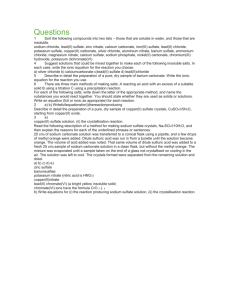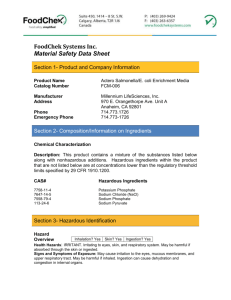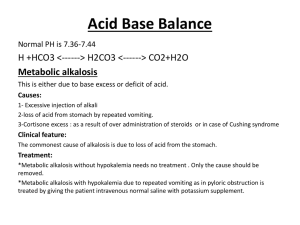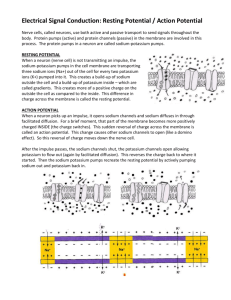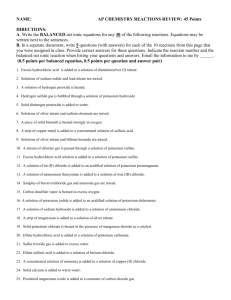A-4 Effects of Minerals on Plant Growth
advertisement
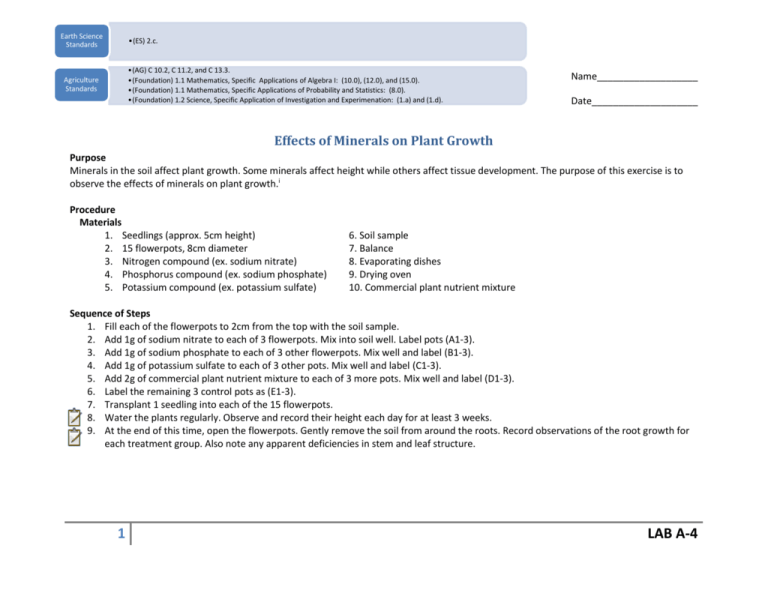
Earth Science Standards •(ES) 2.c. •(AG) C 10.2, C 11.2, and C 13.3. •(Foundation) 1.1 Mathematics, Specific Applications of Algebra I: (10.0), (12.0), and (15.0). •(Foundation) 1.1 Mathematics, Specific Applications of Probability and Statistics: (8.0). •(Foundation) 1.2 Science, Specific Application of Investigation and Experimenation: (1.a) and (1.d). Agriculture Standards Name___________________ Date____________________ Effects of Minerals on Plant Growth Purpose Minerals in the soil affect plant growth. Some minerals affect height while others affect tissue development. The purpose of this exercise is to observe the effects of minerals on plant growth.i Procedure Materials 1. Seedlings (approx. 5cm height) 2. 15 flowerpots, 8cm diameter 3. Nitrogen compound (ex. sodium nitrate) 4. Phosphorus compound (ex. sodium phosphate) 5. Potassium compound (ex. potassium sulfate) 6. Soil sample 7. Balance 8. Evaporating dishes 9. Drying oven 10. Commercial plant nutrient mixture Sequence of Steps 1. Fill each of the flowerpots to 2cm from the top with the soil sample. 2. Add 1g of sodium nitrate to each of 3 flowerpots. Mix into soil well. Label pots (A1-3). 3. Add 1g of sodium phosphate to each of 3 other flowerpots. Mix well and label (B1-3). 4. Add 1g of potassium sulfate to each of 3 other pots. Mix well and label (C1-3). 5. Add 2g of commercial plant nutrient mixture to each of 3 more pots. Mix well and label (D1-3). 6. Label the remaining 3 control pots as (E1-3). 7. Transplant 1 seedling into each of the 15 flowerpots. 8. Water the plants regularly. Observe and record their height each day for at least 3 weeks. 9. At the end of this time, open the flowerpots. Gently remove the soil from around the roots. Record observations of the root growth for each treatment group. Also note any apparent deficiencies in stem and leaf structure. 1 LAB A-4 Observations 1. Using a periodic table, locate the three elements used in this study (nitrogen, phosphorus, potassium). Record the atomic number for each mineral below. 2. Studies show that all elements with an atomic number greater than lithium have been formed by nuclear fusion in stars. Define “nuclear fusion” and determine if the 3 elements used in this lab were formed by nuclear fusion in stars. Table 1. Daily record of plant heights (cm) for treatment groups: (A) Sodium Nitrate, (B) Sodium Phosphate, (C) Potassium Sulfate, (D) Commercial Mix and for the control group (E). Treatment Groups Control Group A1 A2 A3 B1 B2 B3 C1 C2 C3 D1 D2 D3 E1 E2 E3 Day 1 Day 2 Day 3 Day 4 Day 5 Day 6 Day 7 Day 8 Day 9 Day 10 Day 11 Day 12 Day 13 Day 14 Day 15 Total Growth 2 LAB A-4 3. For each plant, write down the height at day 15, and subtract the height at day 1. This is your total growth for each plant. Put this number in the bottom line of the table above. 4. Calculate the average growth for each treatment group and for the control group. For each letter group, add the total growth numbers together and divide by the number of plants used in that group. For example, to find the average growth for plants treated with sodium nitrate (A), add the total growth for A1+A2+A3, and divide by 3. Write the averages below. 5. Root growth observations. After removing the soil from your samples, record your observations for each treatment group and for the control group below. Be specific about details such as length, thickness, and amount of roots. 3 LAB A-4 Table 2. Observations of root growth by treatment group and control group. (A) Sodium Nitrate (B) Sodium Phosphate (C) Potassium Sulfate (D) Commercial Mix (E) Control 6. Based on your observations, describe your results and how this information could help plant producers. i Ecology Investigation: Effects of Minerals on Plant Growth. Boston, Massachusetts: Prentice Hall, Inc. 4 LAB A-4




